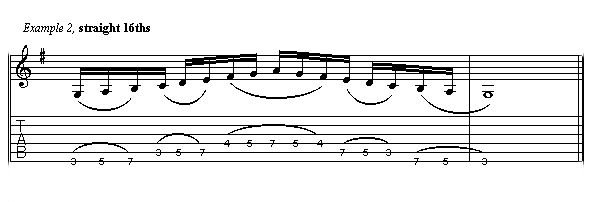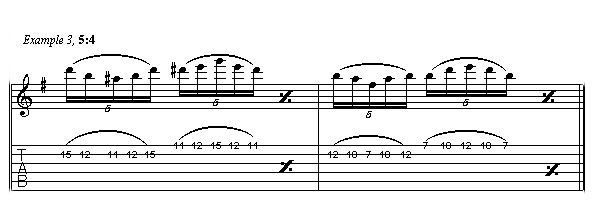One of the most time-consuming aspects of transcribing guitar solos is exacting the phrasing. The guitar is a wonderful instrument of expression, due to its set-up. The spacing of chromatic notes on stringed instruments such as the guitar lends itself to three note patterns rather than the conventional four note patterns which are the basis of our common 4/4 time. Modern guitarists seldom approach a solo concerned about the timing of the notes as long as they all fit. Therefore, three note patterns become the benchmark of faster playing, as well as the cookie cutter for eight tone scales.
This month, we will approach phrasing based not on emotion, but on how to make the notes fit. Many times, the polyrhythmic characteristics actually create a lovely flowing line. Let's look particularly at the G major (E minor) scale. Since Em seems to be the key for rock players, and G major for country, it seems only right.
Now, although I always recommend picking as much as possible, unusual timing typically sounds more fluid as a legato line. In order to get these exercises sounding good, make sure that all four of your fingers are pulling off or hammering on at even tempos. Keep them slow and even, using a metronome set at around 100 bpm, and playing one note per click. Remember to pick only the first note of each phrase that is under the legato curve. Now, let's break them down:

Example 1 - MP3
Example 1 utilizes a common triplet. This is the easiest and most effective way to create a speedy ascending run. Notice that to facilitate the three note per string pattern, there is no E note in the entire climb. In Em, this works well, as it is assumed that the E is being played by the rhythm instruments. In G, it is the 6th scale tone, which can actually be pretty important, but in this case, it runs by rather smoothly.

Example 2 - MP3
Example 2 is much more difficult to keep in time. The best way to practice this one is to slow down the metronome and play 4 notes per click. Isn't it funny that we could actually say that it's difficult to play straight 16th notes in time? Well in this case, legato turns into our enemy, making it a battle between your counting and the tendencies of your hand to fly past in triplets. Be careful!

Example 3 - MP3
Example 3 is by far the most difficult to play in time. A 5 against 4 is
pretty tricky to count out. The key here is to feel it. Set your metronome rather slow, and try to get all ten notes in evenly so it matches up and you begin again on the third click of your metronome. Don't rush to this level. Play it slowly first, one note per click. Once you get it to speed, this can be one of the most effective sounding polyrhythmic patterns available. Notice I added an A# and a D# in the first half, giving it an almost bluesy feel, while in the second half, the expected G is omitted completely.
With all of the above exercises, use other three note per string patterns you may already be comfortable with in the same context. You will eventually get a broader understanding of your scales and ways in which to play them. Have fun and remember that you can only play effectively what you know!
Paul Kuntz is a working studio musician and has been a professional instructor for past ten years. Paul graduated from the Musician's Institute in 1990, and is author of the guitar instructional book "Chords Scales, Theory and Shellfish"..
He also is a studio engineer and producer for unsigned artists.